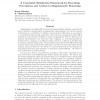Free Online Productivity Tools
i2Speak
i2Symbol
i2OCR
iTex2Img
iWeb2Print
iWeb2Shot
i2Type
iPdf2Split
iPdf2Merge
i2Bopomofo
i2Arabic
i2Style
i2Image
i2PDF
iLatex2Rtf
Sci2ools
116
click to vote
JAIR
2010
2010
A Constraint Satisfaction Framework for Executing Perceptions and Actions in Diagrammatic Reasoning
Diagrammatic reasoning (DR) is pervasive in human problem solving as a powerful adjunct to symbolic reasoning based on language-like representations. The research reported in this paper is a contribution to building a general purpose DR system as an extension to a soar-like problem solving architecture. The work is in a framework in which DR is modeled as a process where subtasks are solved, as appropriate, either by inference from symbolic representations or by interaction with a diagram, i.e., perceiving specified information from a diagram or modifying/creating objects in a diagram in specified ways according to problem solving needs. The perceptions and actions in most DR systems built so far are hand-coded for the specific application, even when the rest of the system is built using the general architecture. The absence of a general framework for executing perceptions/actions poses as a major hindrance to using them opportunistically – the essence of open-ended search in pro...
| Added | 28 Jan 2011 |
| Updated | 28 Jan 2011 |
| Type | Journal |
| Year | 2010 |
| Where | JAIR |
| Authors | Bonny Banerjee, B. Chandrasekaran |
Comments (0)

